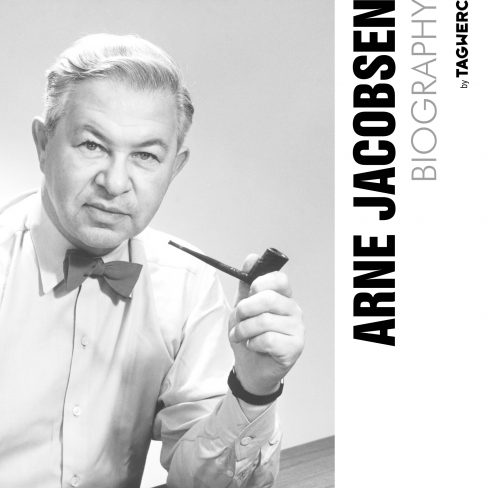
Arne Jacobsen Biography
Arne Emil Jacobsen is probably the most famous Danish designer of the 20th century. However, Jacobsen, who was born in Copenhagen on February 11th, 1902 and died there on March 24th, 1971, was not only a designer, but also an architect and a trained stonemason. Jacobsens designs can be assigned to the style of Functionalism or Danish Modernism and are manufactured by manufacturers such as &tradition, Fritz Hansen, Georg Jensen, Louis Poulsen and Montana. Design objects by Arne Jacobsen are available as licensed originals from premium interior designer TAGWERC.
Odyssey in space
The designer’s initials give the name to the AJ lighting collection by Louis Poulsen. The luminaire family, consisting of AJ Floor, AJ Wall, AJ 50 Wall and AJ Table as well as the pendant lamp AJ Royal and the wall lamp AJ Eklipta. Also known is the cutlery ‘AJ’, also designed by Arne Jacobsen and produced by Georg Jensen, as it plays a supporting role in ‘2001: A Space Odyssey’, the science fiction film classic directed by Stanley Kubrick in 1968.
Education and architecture
Arne Jacobsen grew up as the son of a merchant and a bank employee in good middle-class conditions. His father insisted on a good education and thus Arne Jacobsen enrolled in the study of architecture at the Royal Danish Academy of Arts in Copenhagen in 1924 after completing his apprenticeship as a stonemason, which he completed only three years later. As a self-employed architect in the following years, Jacobsen realized a number of notable construction projects such as the so-called Bellavista settlement with the Bellevue Theater (1932-1935), the petrol station Skovshoved (1936) the city hall of Aarhus (1942), the Radisson Royal Hotel (1956-1960 ), now Radisson Collection Hotel – Royal Copenhagen, modeled after the Lever House by Gordon Bunshaft in New York. As part of this construction project, Arne Jacobsen designs the Egg armchairs, including Egg Chair, and Schwan, known as The Swan (both produced to date by Fritz Hansen).
The Dane in Germany
Arne Jacobsen conceived four buildings at the invitation of the city for the model settlement Southern Hansaviertel in Berlin (1952). In the Great Garden, one of the most important baroque gardens in Europe in Hanover, Germany, Arne Jacobsen creates a glass foyer, which serves as a connecting corridor between the castle and gallery building and limits the baroque garden, the Arne Jacobsen Foyer (1964). An administrative building for the pharmaceutical company Novo Industrie (today Novo Nordisk) is built from 1967 to 1969 in Mainz. For the city of Castrop Rauxel, Arne Jacobsen designs Forum Europaplatz, an event and congress center in the heart of the city, as well as the town hall. Arne Jacobsen designed a hotel complex consisting of three skyscrapers for the south beach on the Baltic Sea island of Fehmarn.
Jacobsen designs
A number of buildings were begun by Arne Jacobsen during his lifetime and can only be completed after his death. Among them is the Christianeum, the school complex of a classical grammar school, and the Vattenfall administration building, both in Hamburg. The Mainz Town Hall as well as the Danish Embassy in London and the Danish National Bank building in Copenhagen. In the Hotel Alexandra, the Retro Hotel in Copenhagen, there is an Arne Jacobsen hotel room, which is intended to pay homage to the most famous design son of the city. The hotel chain Motel One uses the Egg Chair in turquoise as a corporate identity (CI) in the lobby of their budget hotels.
Timeless design classics
One of the last furniture designs is a work and dining table, the so- called DJOB table by Montana, which Arne Jacobsen is said to have created in the year of his demise. One of his earliest designs is the Bellevue Lighting Series (1928) by &tradition, which is available from TAGWERC in all finishes as floor lamp (AJ7), table lamp (AJ8), wall lamp (AJ9) and two recessed table lamps (AJ10 and AJ11). Together with his former business partner Flemming Lassen, the Major Sofa for the Sollerod City Hall was built in 1939, today also produced by &tradition and supplied by TAGWERC as a 2-seater and 3-seater couch.
Apprenticeship at Jacobsen
Arne Jacobsen is already a celebrated designer in 1950, when Verner Panton enrolles in the architecture and design office Jacobsens at the end of his studies. At this time, Jacobsen is designing the Ant, one of his most famous chairs. Through his father-in-law Poul Henningsen, Panton meets Jacobsen. Only years later Panton will say about this, for him difficult time: “The older I get, the more respect I get for Arne Jacobsen, although I have a different view in many things. If you consider all that Arne Jacobsen has done in many areas, there is no one in the world, who can beat him. Of course, his skills were accompanied by talent, energy, economy and luck. And maybe everything was a little too clean. But I have never learned so much from anyone as Arne Jacobsen. Also the uncertainty and never giving up.”
The Arne Jacobsen Collection
TAGWERC presents the Interior Life Work of the legendary Dane, the Arne Jacobsen Collection.









